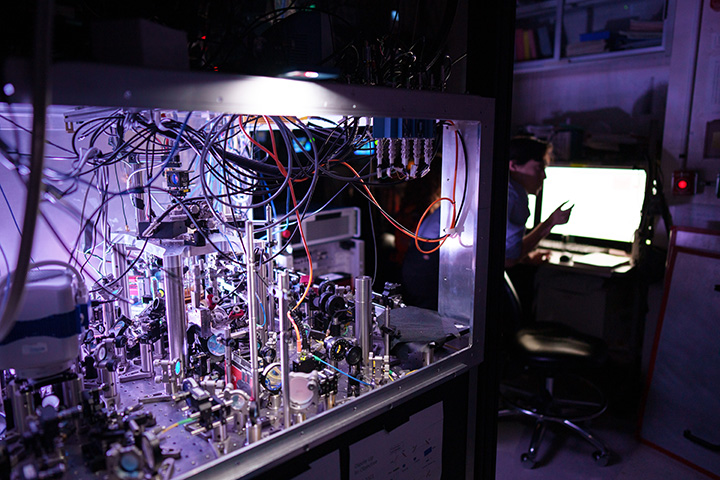In case you haven’t heard (we know you have), quantum computing is the next hot thing. And New Mexico and Roadrunner Venture Studios are getting in on the trend. Yesterday, the venture studio announced that it will lead a $25M initiative backed by the New Mexico Economic Development Department to build a quantum campus in downtown Albuquerque.
The idea is to bring startups, researchers, and major companies working to develop quantum computing capabilities to the beautiful southwest to supercharge US quantum compute. The coalition will include partners such as Elevate Quantum, national laboratories (Sandia, Los Alamos), quantum startups (QuEra, Maybell, Qunnect, Resonance), academic institutions (University of New Mexico), and venture capital firms (DCVC, Playground Global, Quantonation).
And if $25M doesn’t sound like enough to do this, fret not. Roadrunner co-founder and CEO Adam Hammer told Tectonic that he expects this to be the first in a series of investments by New Mexico.
“We’re going to find the best entrepreneurs that want to come build. We’re going to relocate some startups to have operations elsewhere globally to…New Mexico,” he said, “[We will] make this the center of gravity for American quantum development.”
Supercomputer: For the uninitiated among us (or for those who pretend to understand quantum but don’t), a quick refresher: Quantum computing is basically exponentially supercharged computing using the weird and wacky power of quantum physics.
- Normal computers—like the laptop you’re reading this on—use bits, which can be 0 or 1.
- Quantum computers use something called qubits, which can be 0, 1, or a mix of both at the same time. This is something called superposition.
- Qubits can also be linked together—called entanglement—meaning the state of one instantly impacts the other, even if they’re far apart.
- All of this means that quantum computers can try out many different possibilities in parallel, rather than one by one—that’s the way that classical computers work.
Think of a key ring with a bunch of keys on it. A classical computer tries each of those keys one by one until it finds the right one (the right outcome). A quantum computer can try all of the keys at the same time. That’s what makes them exponentially more powerful than classic computers.
And everyone wants their shot at being the quantum master: While the US is still slightly out ahead, China has gone all in. The country has reportedly poured tens of billions of dollars into quantum through the Chinese Academy of Sciences, universities, and military-linked labs. That pesky old military-civil fusion thing again.
Quantum, but make it defense: Now, why do we care? Well, quantum has all sorts of critical defense applications.
- Communication and code-breaking: Most military comms nowadays rely on codes that normal computers have a tough time cracking. Quantum computers could break these codes pretty easily. And quantum-safe comms and encryption would be basically unhackable.
- Logistics: We talk a lot about how tricky military logistics and planning are (and how many companies are trying to solve this). Quantum computers are pretty good at solving these huge, sticky, complex problems.
- Navigation: Quantum sensors can measure teeny-tiny tiny changes in motion, gravity, or magnetic fields. This can be helpful for navigation in GPS-denied or jammed environments.
- Sensing: Quantum sensors can also—using that hypersensitivity—detect hard-to-track objects like stealth aircraft, deep-sea submarines, or hypersonic missiles.
TL;DR, we don’t want to be caught behind the ball. Would be a real pain in the butt if China got to all of this first.
“To me, quantum is the next semiconductor moment. If the United States doesn’t lead, we’re going to follow,” Hammer said. “You don’t have to look far ahead to see what developments the Chinese are making in quantum. They’re making a generational investment. The United States is ahead, but not for long.”
Hammer added that they’ve already teamed up with AFRL to build secure quantum comms, and they’re in talks with the DoD and DARPA to make sure what’s churned out at the campus meets military needs.
Delicate balance: The problem is, qubits are hyper, hyper delicate. Heat, light, noise, vibrations—they can all make them lose their quantum state. Quantum computers need to be kept at absolute zero temperatures using huge refrigerators, and that’s both expensive and power intensive.
Other parts of quantum cost big bucks, too: cryogenics, precision lasers, and superconducting circuits all cost a shit ton of money. To date, that’s meant that only huge companies—Google, IBM, etc—have had pockets deep enough to fund the research.
Hammer said that’s where the campus comes in. The idea is that the Albuquerque facility will provide everything needed (those expensive fridges and power included) to do quantum research—without needing oodles of funding.
The plan is that about half of the $25M will be used to build out these facilities and the skeleton of a neutral atom quantum computer, and the other half will be used to help incubate quantum companies through a “founder in residence” program—that’s Roadrunner’s bread and butter.
“What’s unique about our model is we work between public and private,” Hammer said. “We’re bringing the Department of Defense, the federal government, the state of New Mexico, and the capital markets and startups to play together in this hub in New Mexico.”
The facility will be fully online in June 2026, he said, with incremental launches (like the founder in residence program) in the next year.

